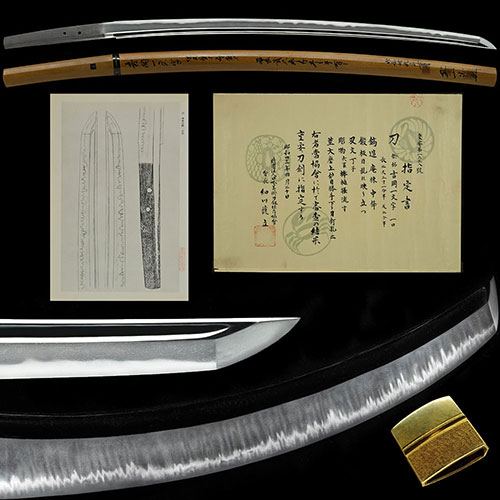
吉岡一文字 刀 Yoshioka Ichimonji Katana
No.573787吉岡一文字 乱れ映り鮮やかに立ち丁子乱れ華やかな健全で品格の高い傑作 二尺三寸一分Yoshioka Ichimonji, Vividly Midare-Utsuritachi, Gorgeouse Chouji-Midare, Kenzen and a gorgeous and elegant masterpiece, 70.1cm.
ご成約Sold
- 極めKiwame
- 吉岡一文字Yoshioka Ichimonji
- 登録証Registration
- 北海道 Hokkaido 昭和26年7月3日 7/3/26(Showa)
- 時代Period
- 鎌倉後期Late Kamakura period
- 法量Size
-
刃長 70.1cm (二尺三寸一分) 反り 1.5cm
元幅 3.2cm 先幅 2.0cm 元重 0.56cm 鎬厚 0.64cm 先重 0.53cm 鋒長 3.2cm 茎長 20.8cm 重量 703gHachou 70.1cm (二尺三寸一分) Sori 1.5cm
Moto-Haba 3.2cm Saki-Haba 2.0cm Moto-Kasane 0.56cm Shinogi-Thikess 0.64cm Saki-Kasane 0.53cm Kissaki-Chou 3.2cm Nakago-Chou 20.8cm Weight 703g - 国Country
- 備前Bizen
- 姿Shape
- 鎬造、庵棟、身幅広く、反り深く、腰反りつき、中鋒。Shinogidukuri, Iorimune, Wide Mihaba, Deep Sori, Koshizori-tsuki, Chu-Kissaki
- 鍛Kitae
- 板目肌に、杢目肌交じり、地沸微塵に厚くつき、乱れ映り立つ。Itamehada, Mixed Mokumehada, Jinie entered fine and thick, Midare-Utsuritatsu.
- 刃文Hamon
- 丁子乱れに、重花風の丁子・袋丁子・蛙子調の丁子・互の目など交じり、飛び焼き掛り、足・葉よく入り、匂出来、小沸深くつき、金筋細かく掛り、匂口明るい。Chouji-Midare, Juka-style-Chouji, Fukuro-Chouji, Kawazuko-style-Chouji, Mixed Gunome, Tobiyaki-kakari, There are Ashi and You frequently, Nioi-deki, Small-Nie entered deeply, Kinsuji hangs finely, Nioikuchi is bright.
- 帽子Boushi
- のたれ込んで小丸。Notarekonde-Komaru.
- 茎Nakago
- 大磨上、先浅い栗尻、鑢目切、目釘孔二。Oh-suriage, Saki-Asai-Kurijiri(Tip Shallow Kurijiri), Yasurimegiri, Mekugiana are two(2)
- ハバキHabaki
- 金着一重。Single Kinkise (Wearing a single layer of gold.)
- 彫物Carving
- 表裏に棒樋を掻き流す。Bohi front and back.
- 説明Drscription
- 鎌倉時代の備前物は、一文字と長船の両派に代表され、一文字派は以後南北長期にかけて福岡・吉岡・岩戸などの地に繁栄し、多くの良工が輩出した。この派が一文字と呼称される所以は、茎に「一」の字をきることに因るが、銘は「一」の字のみのものと、他に「一」の字の下にさらに個銘を加えるもの、また個銘だけのものもある。吉岡一文字派は、福岡一文字派に次いで鎌倉時代末期から南北朝期にかけて繁栄した。一派の代表工には助光・助吉・助茂・助次・助義などがいて「助」を通字としており、作風は、乱れの中に互の目が目立ってやや小出来となるものである。この刀は、身幅広く3.2cmあり、反り深く、中鋒となる鎌倉後期の豪壮な姿で、鮮やかに立つ乱れ映りが鮮やかに立つ美しい地鉄に、重花風の丁子・袋丁子・蛙子調の丁子・互の目など交え華やかに乱れ、足・葉よく入り、金筋・砂流し掛かるなど刃中よく働き、刃肉もしっかり残る頗る健全で品格の高い傑作である。Bizen-mono in the Kamakura period was represented by both the Ichimonji and Osafune schools, and the Ichimonji-ha prospered in Fukuoka, Yoshioka, Iwato, and other areas until the Nanbokucho period, producing many excellent craftsmen. The reason why this school is called Ichimonji is because the character "ichi" is cut on the stem. There are some that add an inscription, and some that only have an individual inscription. The Yoshioka Ichimonji school flourished in the latter half of the Kamakura period, following the Fukuoka Ichimonji school. Sukemitsu, Sukeyoshi, Sukemo, Suketsugu, Sukeyoshi, etc. are the representative craftsmen of the school, and they use 'suke' as a common character, The style of the work is rather small, with Gunome standing out among the Midare.
This sword has 3.2cm wide Mihaba, Deep Sori. It is a magnificent appearance from the late Kamakura period that became Chu-Kissaki. Vividly Midare-Utsuritachi with beautiful Jigane, Juka-style-Chouji, Fukuro-Chouji, Kawazuko-style-Chouji, Mixed Gunome Gorgeouse Midare, There are Ashi and You frequently, Kinsuji and Sunagashi-kakaru, It works well in sword, Haniku remains firmly in place and it is a very Kenzen and highly dignified masterpiece.


